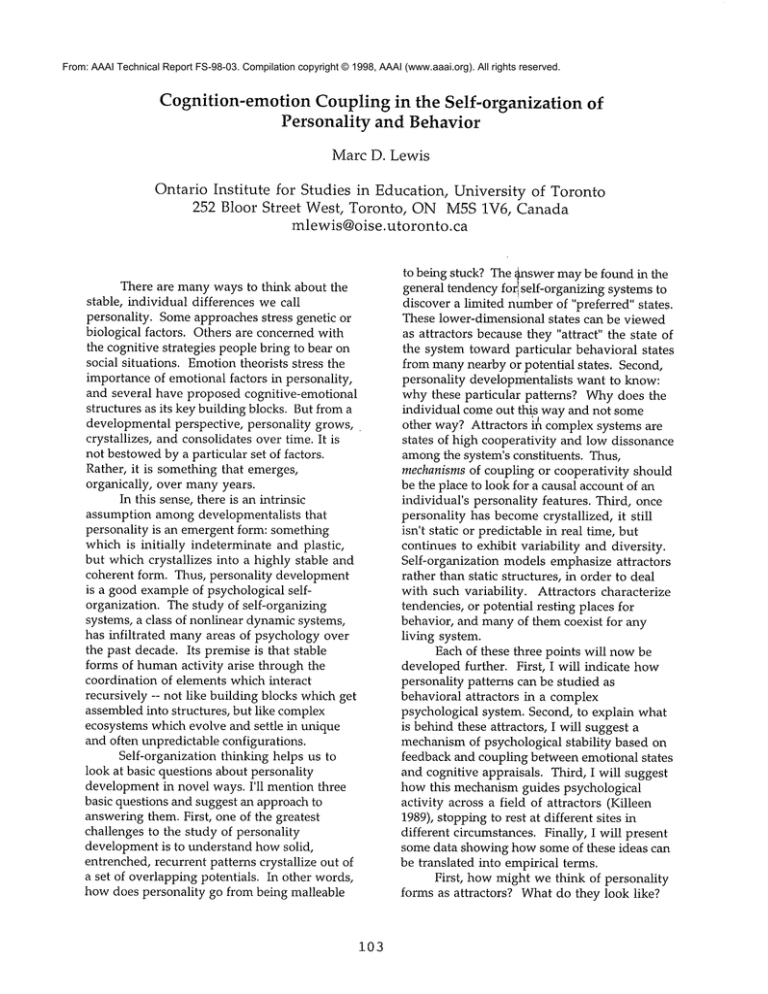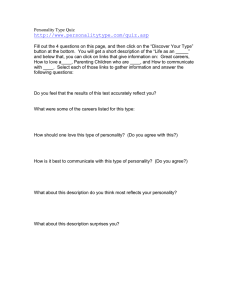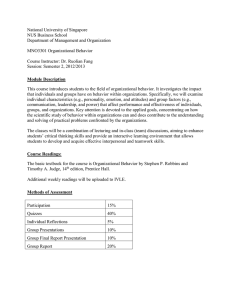
From: AAAI Technical Report FS-98-03. Compilation copyright © 1998, AAAI (www.aaai.org). All rights reserved.
Cognition-emotion
Coupling in the Self-organization
Personality
and Behavior
of
Marc D. Lewis
Ontario Institute for Studies in Education, University of Toronto
252 Bloor Street West, Toronto, ONM5S1V6, Canada
mlewis@oise.utoronto.ca
to being stuck? The answer may be found in the
general tendency fo~ self-organizing systems to
discover a limited number of "preferred" states.
These lower-dimensional states can be viewed
as attractors because they "attract" the state of
the system toward particular behavioral states
from many nearby or potential states. Second,
personality developmentalists want to know:
why these particular
patterns? Why does the
individual come out this way and not some
other way? Attractors ~n complex systems are
states of high cooperativity and low dissonance
amongthe system’s constituents. Thus,
mechanisms of coupling or cooperativity should
be the place to look for a causal account of an
individual’s personality features. Third, once
personality has becomecrystallized, it still
isn’t static or predictable in real time, but
continues to exhibit variability and diversity.
Self-organization
models emphasize attractors
rather than static structures, in order to deal
with such variability.
Attractors characterize
tendencies, or potential resting places for
behavior, and many of them coexist for any
living system.
Each of these three points will now be
developed further. First, I will indicate how
personality patterns can be studied as
behavioral attractors in a complex
psychological system. Second, to explain what
is behind these attractors, I will suggest a
mechanism of psychological stability based on
feedback and coupling between emotional states
and cognitive appraisals. Third, I will suggest
how this mechanism guides psychological
activity across a field of attractors (Killeen
1989), stopping to rest at different sites in
different circumstances. Finally, I will present
some data showing how some of these ideas can
be translated into empirical terms.
First, how might we think of personality
forms as attractors? What do they look like?
There are many ways to think about the
stable, individual differences we call
personality. Someapproaches stress genetic or
biological factors. Others are concerned with
the cognitive strategies people bring to bear on
social situations. Emotion theorists stress the
importance of emotional factors in personality,
and several have proposed cognitive-emotional
structures as its key building blocks. But from a
developmental perspective, personality grows,
crystallizes, and consolidates over time. It is
not bestowed by a particular set of factors.
Rather, it is something that emerges,
organically, over many years.
In this sense, there is an intrinsic
assumption among developmentalists
that
personality is an emergent form: something
which is initially indeterminate and plastic,
but which crystallizes into a highly stable and
coherent form. Thus, personality development
is a good example of psychological selforganization. The study of self-organizing
systems, a class of nonlinear dynamic systems,
has infiltrated
many areas of psychology over
the past decade. Its premise is that stable
forms of human activity arise through the
coordination of elements which interact
recursively -- not like building blocks which get
assembled into structures, but like complex
ecosystems which evolve and settle in unique
and often unpredictable configurations.
Self-organization thinking helps us to
look at basic questions about personality
development in novel ways. I’ll mention three
basic questions and suggest an approach to
answering them. First, one of the greatest
challenges to the study of personality
development is to understand how solid,
entrenched, recurrent patterns crystallize out of
a set of overlapping potentials. In other words,
how does personality go from being malleable
103
An attractor is a state that behavior gravitates
toward, or tends toward, from a range of other
states. Onceit gets there, it becomesdifficult to
dislodge, and it tends to return to that state
rapidly following perturbations. These twin
criteria, endurance and resistance to
perturbation, are useful means for defining
attractors in nonmathematical applications.
From the point of view of emotion theory,
stable personality forms include what Izard
(e.g., Izard & Malatesta 1987) has referred
as affective-cognitive structures: these are
propensities to interpret events in particular
ways in association with particular emotions
(e.g., suspicion of others, depressiveness, selfdeprecation). Moreover, affective-cognitive
structures characteristically arise in a given
class of situations, and may include defense
mechanisms under certain conditions, thus
giving rise to a richer but nevertheless distinct
array of emotion-cognition pairings. Are such
forms aptly described as attractors? First, they
exhibit endurance within individuals, or they
would not be considered characteristic.
Second,
they resist pressures to change and, in fact,
their endurance may be related to their
resistance to the many perturbations of daily
life. Third, they are high-probability endstates with respect to an array of initial
conditions, thus displaying the properties of
basins. Finally, they resume rapidly following
fluctuations, thus displaying the rapid
relaxation time characteristic of attractors in
any system.
Looking at personality forms as
attractors, then, a reasonable way of
portraying personality as a whole is a map of a
person’s psychological state space -- the space
of all the possibilities for interpretation,
feeling, and behavior. This space can be
mapped according to the values on two
variables measured concurrently -- one
representing a cognitive appraisal and one
representing an emotional state.
Moving now to the second question: why a
particular pattern for a given individual?
Personality forms viewed as attractors denote
the precise points at which a balance emerges
among the cooperative and competing forces
within the psychological system. This balance
is not equilibrium in the classic sense. It is a
state that is capable of self-perpetuation,
through a stabilizing feedback process.
Most emotion theorists agree that
cognitive appraisal gives rise to emotion when
it denotes a class of situations relevant to the
self and its goals. Emotion, in turn, steers
perceptual and cognitive activity toward
influencing the present situation in some useful
manner. If we look at these two processes
simultaneously, we may say that emotion is
continuously enhanced or modified by changes
in appraisal, while appraisal is progressively
updated by cognitive adjustments resulting from
emotion. This process of reciprocation can be
seen as a positive feedback cycle through
which cognitive and emotional activities
affect each other, like autocatalytic reactions
in chemist W(Lewis 1995, 1996). According
self-organization
theory, positive feedback
cycles of exactly this sort are the well-spring of
spontaneously emerging properites. They are
the means by which elaborate forms evolve,
building on themselves over many iterations.
But why do cognitive-emotional
feedback
cycles stabilize? The answer may be found in
the idea that emotions catalyze links among
cognitive elements by favoring combinations
that make sense of the present situation, and
make sense according to the aims of those
emotions. Deviations from such "sensible"
interpretations
are reduced by negative
feedback, in that alternative "nonsensible"
associations are deactivated or resisted. They
automatically drop out of attention because
they are discrepant with the gist of the
dominant interpretation.
In anger, for example,
goal frustration and reduced personal agency
are templates for cognitive coherence.
Conceptual elements draw together into a script
for thwarted goals -- whether a plan to
redouble one’s efforts or a scrap of dialogue from
a CEnt Eastwood movie. These combinations
perpetuate the emotion of anger, due to their
coherence, and anger continues to activate them
in turn. Alternative script components, such as
those concerned with trust or acceptance, are
quickly deactivated. Thus, cooperativity and
coherence evolve through feedback and
stabilize the feedback process. This reciprocal
selection between an emotional state and a
cognitive interpretation can be referred to as
cognition-emotion coupling.
In studying personality development, we
want to understand why particular cognitionemotion patterns emerge and stabilize for
particular individuals. It is a general feature
104
of development that coupling on each occasion
makes components more complementary with
each other and more likely to activate each
other on subsequent occasions. This principle
has been central in the understanding of
developmental self-organization
(Thelen
Smith 1994) and is a longstanding premise of
neurobiological development In the
interpersonal domain, perhaps the best
example is the complementarity that emerges
between a view of the self and a view of the
other. A view of the self as needy emerges
along side a view of the other as unavailable or
rejecting. Thus, individual forms grow out of
the increasing cooperativity of particular
cognitive constituents -- with each other and
with an emotion (Lewis 1996). Some
combinations become highly stable while
others rarely or never stabilize. In this way,
observed attractors always tell us about
cognition-emotion and cognition-cognition
complementarities that have evolved in
development.
The third basic question was about
reconciling personality "stuckness" with
variability and unpredictablility
in real-time
behavior. In living systems, a variety of
attractors coexist at any time. Thus, a
personality is best construed as a field of
attractors (Killeen 1989). Behavior can
gravitate to one of several stable states given
situational context and internal state. Each
new situation has its own emergent properties
and each demands a kind of "choice" of the
psychological system: what will it be this
time? What developmental mechanism of
stability would permit this degree of "choice"?
One answer is to say that it is not behavioral
forms themselves that stabilize or crystallize.
Rather, it is cognitive and emotional
complementarities,
pathways at the
microscopic scale, that crystallize over age.
What do we buy by saying that cognitionemotion complementarities crystallize
over
development but behavioral forms remain
plastic? Two things: First, a way to understand
personality stability.
The same
complementarities can underpin a range of
attractors. For example, perceiving oneself as
helpless without the support of powerful
others is a cognitive complementarity that can
couple with emotion in several ways, producing
a limited range of cognition-emotion
complementarities. It can give rise to a
demanding, aggressive mode when coupled
with anger; a self-effacing
mode when coupled
with shame; and a depressive construal of
abandonment when coupled with sadness.
Thus, a stable personality can be described as
the totality of attractors that express
complementary complementarities
-overlapping complementarities -- among a
system of interacting elements. The second
thing we buy is the potential to explain
personality
change. As emphasized by Magai
& McFadden(1995), personality undergoes
major and often abrupt changes. But these
changes are not unlimited. Westill recognize
the boy in the man. I suggest that these changes
are constrained by complementarities that
have already crystallized.
The belligerent,
aggressive child may become a sly,
manipulative teenager, but is not likely to
become warm and trusting.
The
complementarity between cognitive construals
of threat and blame, and their tendency to
couple with the emotion of anger, does not go
away. Yet it does evolve, taking on additional
elements that are compatible with those
already present. Cognition-emotion coupling
permits new forms to follow old, not by
replacement, but, as in evolution, by mutations
that work together with the whole.
I have argued that personality
development can be described as an emerging
mosaic of attractors. Each attractor stands for a
self-perpetuating,
coherent relation between a
cognitive interpretation
and an emotional
state. But how could we study such patterns
empirically?
How might we look at
personality forms as expressing
complementarities yet coalescing through
cognition-emotion coupling? As a first step in
this direction, we examined infants’ behavior
following a brief separation from mother, over
three weekly sessions at ages 2 and 6 months
(Lewis & Douglas 1998). Wewere interested
how to show attractors,
denoting patterns of
cognition-emotion coupling, at different ages.
The behavior that we observed can be thought
of as a coping response that included cognitive
and emotional constituents.
Rather than
representing these constituents as continuous
variables, appropriate for a mathematical
model, we operationalized
them as ordinal
variables that could be reliably coded from
videotapes and yet could measure relative
distances between values. We operationalized
105
2 Months
6 Months
Session1
Session1
E
S
T~
5
3
4
2
1
5
4
Session2
3
2
1
2
1
2
!
Session2
A
0
0
5
4
3
2
1
5
4
Session3
3
Session3
’l
i
S
______------0
5
4
3
2
1
5
4
3
Angle of Gaze
Figure 1.
State
space grids
for three
sessions
106
at each of two ages for one infant.
the cognitive constituent as attentional focus:
The infant’s gaze was rated as being on-face (1),
peripheral (2), neutral (3), mild gaze aversion
(4), or extreme gaze aversion (5). Emotion
operationalized as the intensity of facial
distress, using a derivative of the MAX
system,
with a range of five values from no distress (0)
to high distress (4).
As shown in Figure 1, a state space grid
was constructed, representing all possible
coordinates of the two variables as a 25-cell
matrix (gaze on the x-axis, distress on the yaxis). Each subject’s behavioral trajectory was
then mapped as a time line that moved from
cell to cell, depicting the sequence and duration
of behavioral events. Events are represented by
circles whose size is proportional to their
duration. The path connecting the circles is a
real-time behavioral trajectory,
showing how
behavior flowed and pooled, like a river on a
landscape. Finally, we identified regions of
highest cumulative duration, where behavior
tended to pool most, using simple statistical
procedures. These hypothetical attractors
were tested for the probability with which
behavior approached them, as compared with
other cells, and for the rapidity with which
behavior returned after leaving. These
measures of "attractiveness" significantly
predicted the recurrence of hypothetical
attractors across same-age sessions (X2 = 6.03, p
< .05, accounting for 66.2% of the variance).
What did the maps show us? One infant’s
sessions at both ages are depicted in Figure 1.
At 2 months, low distress (and probably
interest/excitement)
appears to couple.with
attention to the mother’s face. But when
distress is high, attention moves to neutral gaze
and returns to the same cell rapidly following
fluctuations.
Here, negative emotion and
disengagement appear strongly linked. But
there is no evidence of behavioral consistency
at this age. At 6 months, on the contrary,
moderate distress corresponds with peripheral
gaze at mother for all three sessions. At 2
months, intense anxiety may preclude attention
to mother, whereas her absence from the visual
field may maintain anxiety. Positive emotion,
on the other hand, maintains and is maintained
by full engagement. At 6 months, a consistent
"habit" has emerged: peripheral engagement
modulates distress while moderate distress
(e.g., anxiety) holds attention to the outlines
but not the features of mother’s face. Possible
complementarities underlying these different
behavioral patterns are (1) coupling between
anxiety and loss and (2) coupling between
interest/excitement
and visual engagement.
The 6-month configuration suggests a
complementarity that subsumes both of these:
attention and interest are maintained but now
coupled with anxiety as well.
This sort of methodology may provide a
tool for looking at early coping styles and
perhaps early personality development in a
new way. What the grids show is that
behavior can move around a great deal, yet
gravitate to preferred states, and return to
those states following fluctuations. These
states can easily be represented as intersections
between the values of cognitive and emotional
parameters. Behavior patterns can emerge
spontaneously and somewhat unpredictably in
real time, but the attractors to which they
move suggest enduring complementarities.
Implications for computer modeling include
random walks about a state space where
particular regions optimize feedback between
emotional states and cognitive plans or
appraisals.
References
Izard, C. E., & Malatesta, C. (1987).
Perspectives on emotional development I:
Differential emotions theory of early
emotional development. In J. D. Osofsky (Ed.),
Handbook of infant development (pp. 494-554).
New York: Wiley.
Killeen, P. R. (1989). Behavior as a trajectory
through a field of attractors. In J. R. Brink &
C. R. Haden (Eds.), The computer and the brain:
Perspectives on humanand artificial
intelligence.
North-Holland: Elsevier.
Lewis, M. D. (1995). Cognition-emotion
feedback and the self-organization
of
developmental paths. Human Development,
38, 71-102.
Lewis, M. D. (1996). Self-organising cognitive
appraisals. Cognition and Emotion, 10, 1-25.
Lewis, M. D. (1997). Personality selforganization: Cascading constraints on
cognition-emotion interaction. In A. Fogel, M. C.
107
Lyra, & J. Valsiner (Eds.), Dynamics and
indeterminism in developmental and social
processes.
Mahwah, NJ: Erlbaum.
Magai, C., & McFadden, S.H. (1995). The role
of emotions in social and personality
development: History, theory, and research.
New York: Plenum.
Lewis, M. D., & Douglas, L. (1998). A dynamic
systems approach to cognition-emotion
interactions in development. In M. F. Mascolo
& S. Griffin (Eds.), What develops
emotional development. New York: Plenum.
Thelen, E., & Smith, L. B. (1994). A dynamic
systems approach to the development of
cognition and action. Cambridge, M.A:
Bradford/MIT Press.
108





